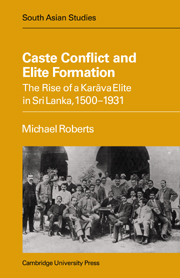Book contents
- Frontmatter
- Contents
- List of figures, chart and maps
- List of tables
- Preface
- Glossary
- List of abbreviations
- Map 1 The Kingdoms of Kotte and Kandy
- Map 2 Some physical features and place names
- Map 3 Present administrative divisions and the contemporary migration patterns of fishermen
- Map 4 The coastal waters of Sri Lanka and southeastern India
- 1 Introduction
- 2 The Karāva in the past
- 3 Caste among the Sinhalese
- 4 Economic opportunities and social relations, 1500s–1790s
- 5 The British period: the economic advances of a Karāva elite
- 6 Social competition, caste conflict and manifestations of Karāva power
- 7 Casteism in South Asian politics during British times: emergent cultural typifications or elite fictions?
- 8 Causal factors in the moulding of Karāva entrepreneurship and the emergence of a Karāva elite
- 9 Concluding remarks
- Tables
- Appendix 1 Problems and cautionary notes concerning the information derived from the plantation directories in the sequential series known as Ferguson's Ceylon Directory
- Appendix 2 A contemporary newspaper account of the reception provided for a Karāva notable on his receiving the title of ‘Mudaliyar of the Governor's Gate’ in 1853
- Appendix 3 A list of caste pamphlets and caste literature in chronological order, 1864–1930
- Select bibliography
- Index
6 - Social competition, caste conflict and manifestations of Karāva power
Published online by Cambridge University Press: 30 October 2009
- Frontmatter
- Contents
- List of figures, chart and maps
- List of tables
- Preface
- Glossary
- List of abbreviations
- Map 1 The Kingdoms of Kotte and Kandy
- Map 2 Some physical features and place names
- Map 3 Present administrative divisions and the contemporary migration patterns of fishermen
- Map 4 The coastal waters of Sri Lanka and southeastern India
- 1 Introduction
- 2 The Karāva in the past
- 3 Caste among the Sinhalese
- 4 Economic opportunities and social relations, 1500s–1790s
- 5 The British period: the economic advances of a Karāva elite
- 6 Social competition, caste conflict and manifestations of Karāva power
- 7 Casteism in South Asian politics during British times: emergent cultural typifications or elite fictions?
- 8 Causal factors in the moulding of Karāva entrepreneurship and the emergence of a Karāva elite
- 9 Concluding remarks
- Tables
- Appendix 1 Problems and cautionary notes concerning the information derived from the plantation directories in the sequential series known as Ferguson's Ceylon Directory
- Appendix 2 A contemporary newspaper account of the reception provided for a Karāva notable on his receiving the title of ‘Mudaliyar of the Governor's Gate’ in 1853
- Appendix 3 A list of caste pamphlets and caste literature in chronological order, 1864–1930
- Select bibliography
- Index
Summary
The previous chapter confirmed that in the nineteenth and twentieth centuries a substantial proportion of the Sinhalese rich and the Sinhalese in prestigious positions were drawn from the Karāva caste. While their relative share was comparatively large, it will be evident that the number of Karāva who used the avenues of social mobility to advantage were relatively few. One can, on the evidence presented so far, speak only of ‘the rise of a Karāva elite’ rather than the ‘rise of the Karāva’.
This reconstruction has now brought us to a junction where the story takes two directions: one seeks to explain how and why such a successful elite emerged from within the Karāva caste rather than other castes. This is our primary interest. But first we must look at the social and political struggles of the Karāva under the inspiration of their emerging elite families or older headmen families. These families found that their social and ritual status was not congruent with their economic power. Taking advantage of the loosening of caste-regulated restrictions on life-style and the relaxations in caste-regulated administrative practice during British times, they set out to improve their social station and that of the Karāva caste as a whole. This raises questions regarding the degree to which these elite families were responding to the sentiments of the Karāva people, and whether one is justified in considering the Karāva to have possessed a sense of community before the Karāva elite developed into an articulate force. These are questions that have been hotly debated with regard to upwardly mobile castes in India during the nineteenth and twentieth centuries.
- Type
- Chapter
- Information
- Caste Conflict Elite Formation , pp. 131 - 179Publisher: Cambridge University PressPrint publication year: 1982



